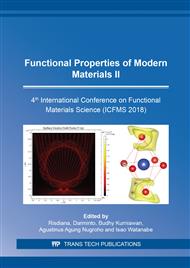[1]
C.-C. Yang, Hydrogenated Amorphous Silicon Carbide Prepared using DC Saddle Field PECVD for Photovoltaic Applications, Master Thesis, University of Toronto, Canada, (2011).
Google Scholar
[2]
S. M., J. Chul, J. Lee, J. Jang, Y.-J. Lee, and J. Yi, Single- and Multiple-Junction p-i-n Type Amorphous Silicon Solar Cells with p-a-Si1-xCx: H and nc-Si:H Films, in Photodiodes - From Fundamentals to Applications, I. Yun, Ed. InTech, (2012).
DOI: 10.5772/51732
Google Scholar
[3]
E. Yahya, Density of gap states in hydrogenated amorphous silicon, Retrospective Theses and Dissertations 8230, Iowa State University, (1984).
Google Scholar
[4]
N. Brinkmann, D. Sommer, G. Micard, G. Hahn, and B. Terheiden, Electrical, optical and structural investigation of plasma-enhanced chemical-vapor-deposited amorphous silicon oxynitride films for solar cell applications, Solar Energy Materials and Solar Cells 108 (2013)180–188.
DOI: 10.1016/j.solmat.2012.09.025
Google Scholar
[5]
F. Edelman, A. Chack, R. Weil, R. Beserman, Yu. L. Khait, P. Werner, B. Rech, T. Roschek, R. Carius, H. Wagner, W. Beyer, Structure of PECVD Si:H films for solar cell applications, Solar Energy Materials & Solar Cells 77 (2003) 125-143.
DOI: 10.1016/s0927-0248(02)00274-x
Google Scholar
[6]
Z. Remeš, Study of defects and microstructure of amorphous and microcrystalline silicon thin films and polycrystalline diamond using optical methods, Ph.D.Thesis, Charles University, Prague, (1999).
Google Scholar
[7]
J. F. Muth, J. H. Lee, I. K. Shmagin and R. M. Kolbas, Absorption coefficient, energy gap, exciton binding energy, and recombination lifetime of GaN obtained from transmission measurements, Appl. Phys. Lett. 71 (1997) 2572.
DOI: 10.1063/1.120191
Google Scholar
[8]
S. Lin, Y. Chan, D. Webb, and Y. Lam, Gap states and stability of rapidly deposited hydrogenated amorphous silicon films, Materials Science and Engineering: B 72 (2000) 197–199.
DOI: 10.1016/s0921-5107(99)00513-9
Google Scholar
[9]
S. Baek, J. C. Lee, Y.-J. Lee, A. M. Iftiquar, Y. Kim, J. Park, J. Yi, Interface modification effect between p-type a-SiC:H and ZnO:Al in p-i-n amorphous silicon solar cells, Nanoscale Res. Lett. 7 (2012) 81.
DOI: 10.1186/1556-276x-7-81
Google Scholar
[10]
S. K. Sharma, H. Im, D. Y. Kim, and R. M. Mehra, Review on Se-and S-doped hydrogenated amorphous silicon thin films, Appl. Phys. 52 (2014) 21.
Google Scholar


